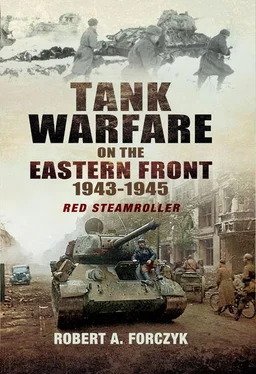While Hoth’s 4. Panzerarmee had inflicted grievous armour losses on Rotmistrov’s ill-timed 5 GTA counter-attack, the combination of mines, anti-tank guns, artillery and air attacks had in fact worn down the German combined arms team – just as the Stavka had intended. Hoth could still cobble together an armoured spearhead with his remaining tanks, but it was the loss of Panzergrenadiers and pioniers that made further advance problematic. By 15 July, von Manstein’s forces had suffered over 28,000 casualties, including 5,600 dead or missing. {128} Altogether, the three Panzerkorps committed to Zitadelle by Heeresgruppe Süd still had 340 tanks (including 134 Pz IV and 33 Tigers) and 156 assault guns operational (about one-third of starting strength). According to Zetterling, Heeresgruppe Sud lost only 119 tanks and 10 assault guns during Zitadelle , but this means that over 800 AFVs were under repair. {129} Although Kursk was not a ‘death ride’ for the Panzerwaffe, a number of German Panzer units, such as all three Panzer-Divisionen in Breith’s III. Panzerkorps and the Panther brigade, were rendered combat-ineffective due to losses. Indeed, half of von Manstein’s remaining armoured combat power was concentrated in Hausser’s II.SS-Panzerkorps, with the other two Panzerkorps were no longer capable of attacking. The suggestion that the II./SS-Panzerkorps could have made any significant advance northward after the action at Prokhorovka on 12 July is absurd on a number of levels, beginning with the reality that the factors that were still slowing the German armour – the mines, anti-tank guns and artillery, as well as the lack of infantry to cover the flanks – were still intact. Soviet airpower was also intact and causing frequent damage to Panzer units in the open.
Operation Zitadelle was not the ‘death ride’ of the Panzerwaffe, as Soviet historians tried to depict for years. Far from it. Yet neither was Zitadelle a ‘lost victory’ as von Manstein claimed, since the Soviets were already at the point where they could replace losses far more rapidly than the Germans. Rather, Zitadelle was the end of the road for the traditional German combined arms team, built upon the integration of mechanized manoeuvre forces and close air support. After Kursk, the Germans still had plenty of tanks and assault guns, but fewer and fewer supporting arms, air support or veteran leaders. It was the German infantry divisions that were disintegrating, which made it increasingly difficult for the panzers to hold or retake ground.
Furthermore, the Germans learned the wrong lessons about tank warfare at Kursk – that it was a tank gunnery contest and that the side that outgunned the other won. The Tigers had done very well during Zitadelle , inflicting greatly disproportionate losses on the enemy and absorbing enormous punishment. Only 11 of 117 Tigers were destroyed during Zitadelle , although their operational readiness rate was very low so it was rare for more than a few Tigers to be involved in any given action. Increasingly, the Germans placed their faith in long 7.5cm and 8.8cm guns, at the expense of manoeuvreability. The Pz III had generally been kept in the background during Zitadelle and the Pz IV was now regarded as second-rate. Despite its shabby performance, Hitler and the OKH believed that the Panther would eventually counter-balance the Soviet numerical superiority in tanks. New heavy tanks, like the 68-ton King Tiger under development, were regarded as the answer to Soviet numbers, not trying to build a better medium tank. Effectively, after Kursk the Wehrmacht abandoned its interest in building more or better 30-ton tanks and settled on the fantasy that smaller numbers of super-heavy tanks would alter the trajectory of a lost war.
Soviet losses at Kursk are more difficult to pin down, but the Voronezh and Steppe Fronts suffered approximately 148,000 casualties in stopping von Manstein’s offensive and lost between 1,600–1,900 tanks and self-propelled guns. However, the Steppe Front continued to pour fresh reserves into the battle even as Hitler called off the offensive and Vatutin’s armoured formations still had between 1,500–1,900 operational tanks and self-propelled guns. Painful losses suffered against Panther and Tiger tanks finally encouraged the GABTU to press for an upgraded main armament for the T-34 and a new heavy tank; these two initiatives would lead to the introduction of the T-34-85 and the IS-2 within six months. However, the Red Army still regarded the medium tank as its primary mobile combat system and heavy tanks were intended only to level the playing field when enemy heavy tanks appeared.
In contrast to the Wehrmacht, the Battle of Kursk helped the Red Army to recognize that armoured warfare was not just about tanks and they learned to use their anti-tank and artillery capabilities to balance the tactical shortcomings of their tanks. Failures at Kursk taught the Red Army that launching hasty, ill-planned operations was counter-productive and as a result, the Red Army tried to fight in more methodical fashion. In time, Soviet improvements in combined arms warfare proved more decisive than German skill in tank gunnery.
Another aspect of the Battle of Kursk which is rarely considered is its indecisiveness. Neither side achieved what it hoped to accomplish in this inordinate expenditure of resources. On the Soviet side, the Red Army wanted the German armour to literally ‘impale’ itself on mines and anti-tank gun barriers, but was risk-averse to allowing the Germans to achieve any kind of breakthrough. Every time German armour threatened to break through a Soviet defensive line, the Soviet commander committed most of his available armour to counter-attack it, resulting in head-in engagements with German assault groups. However, in order for the Red Army to achieve any kind of decisive success at Kursk, Soviet tactical commanders needed to allow German spearheads to advance into the depth of the defence, creating vulnerable flanks. Given the forces available for Zitadelle , there was no way that the German pincers could have reached Kursk and held a viable front with the limited number of divisions available. Von Manstein would have required a dozen extra divisions to hold the flanks of a penetration stretching to Kursk. Yet lacking these divisions, deeper German penetrations meant longer, weaker flanks. If Stalin had granted Rokossovsky and Vatutin the flexibility to allow some loss of ground, Soviet armoured counter-attacks against the extended German salient would have increased the possibility of surrounding and destroying some of the attacking Panzer-Divisionen.
On the German side, lack of operational flexibility robbed Zitadelle of any chance of achieving decisive results even before it started. The Germans knew very well that the Soviets had identified their likely attack sectors and were deploying strong forces to block them. Without surprise or a favourable correlation of forces, Zitadelle was limited to being a frontal assault. However, the Germans could have used the obvious tactic of a double pincer attack as a deception to fix large Soviet forces in place, while shifting the actual axis of attack to the face of the Kursk salient. If both Model and von Manstein had shifted part of their armour against the relatively weak 38th and 60th Armies, while mounting strong feints against the expected attack sectors, they likely would have achieved operational surprise and an overwhelming local superiority. Soviet operational reserves were poorly deployed to respond quickly to a threat to the face of the salient, which would have delayed any response. Furthermore, the face of the Kursk salient was defended by far fewer mines and anti-tank guns, which would have increased the chance of a rapid breakthrough. By smashing in the face of the Kursk salient – which likely would have been far less costly than trying to reach Kursk through three lines of defence, von Manstein might have reduced the size of the Kursk salient and thereby shortened his front line. By ‘hitting them where they weren’t’ – a tactic favored by the Panzerwaffe in 1941–42 – the Germans might have achieved one or more nice tactical victories in the summer of 1943, as they had in the past. However, inflexibility was the downfall of Zitadelle , since rather than using manoeuvre, the German commanders opted for brute force.
Читать дальше








![John Stieber - Against the Odds - Survival on the Russian Front 1944-1945 [2nd Edition]](/books/405234/john-stieber-against-the-odds-survival-on-the-russian-front-1944-1945-2nd-edition-thumb.webp)



